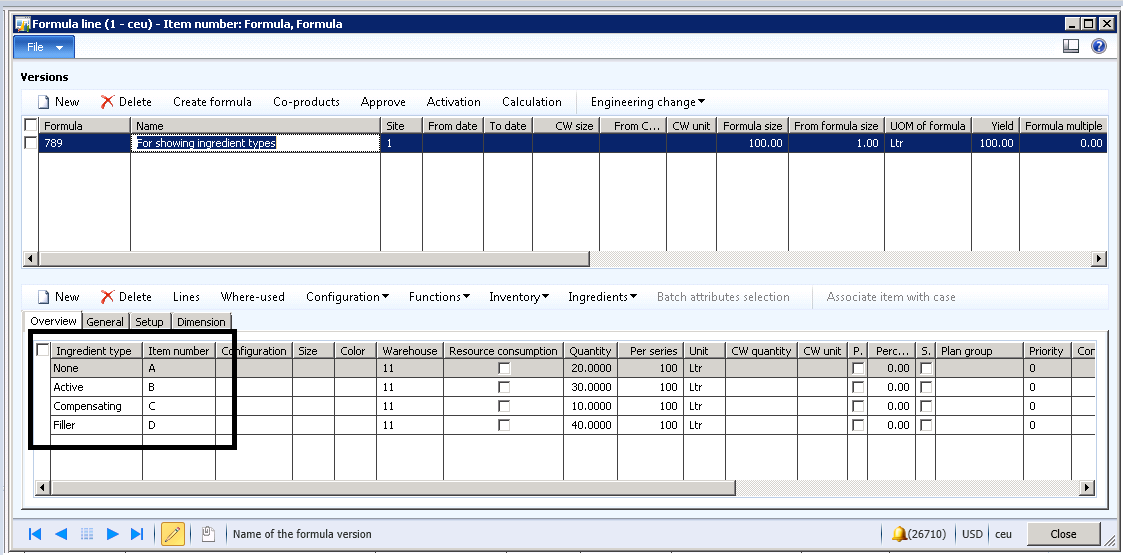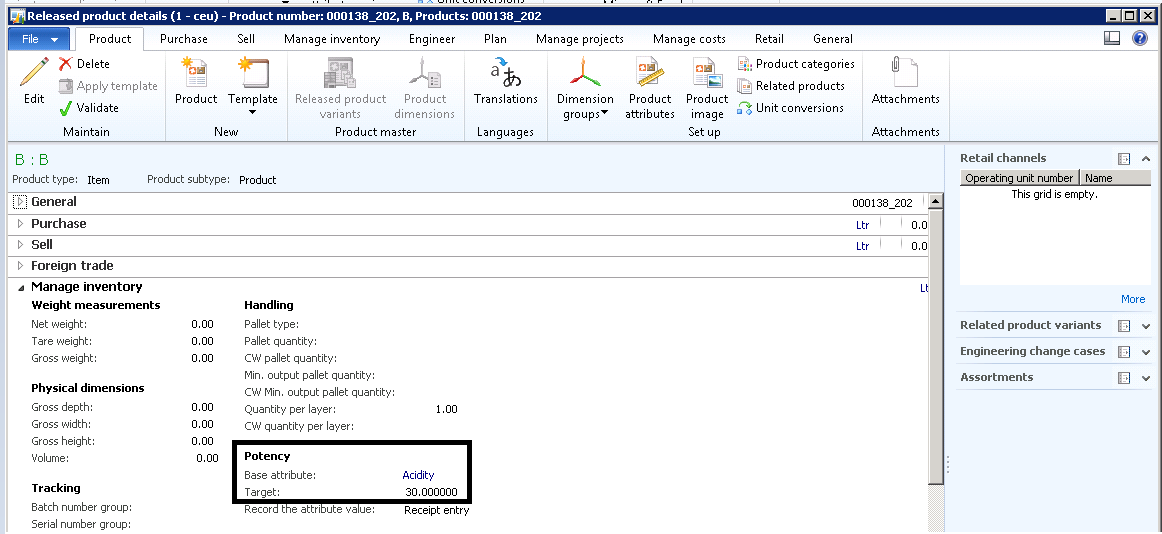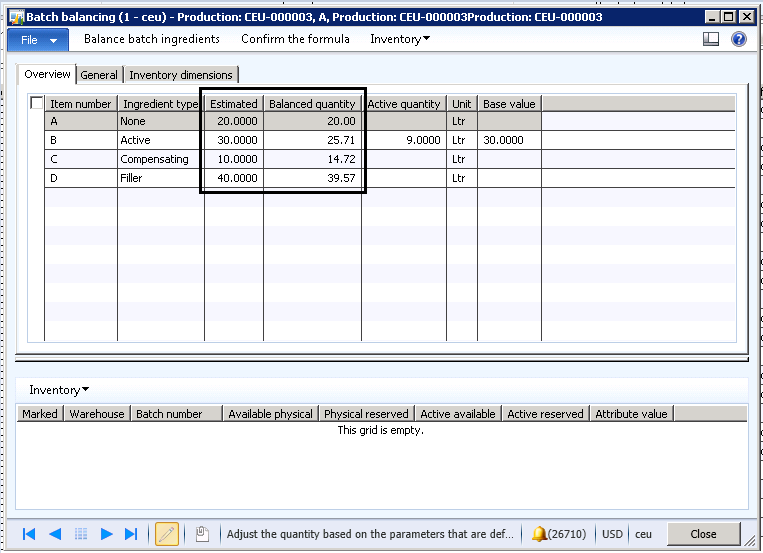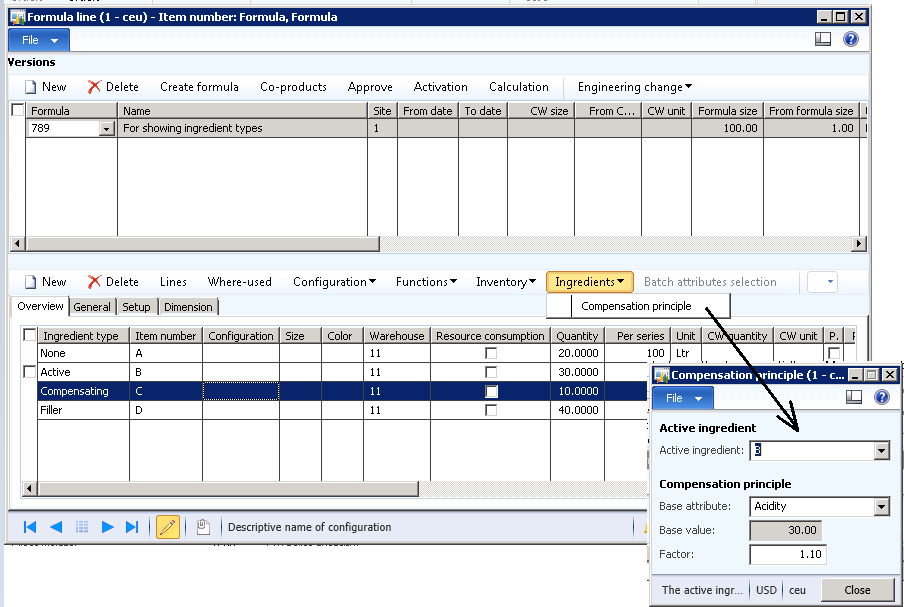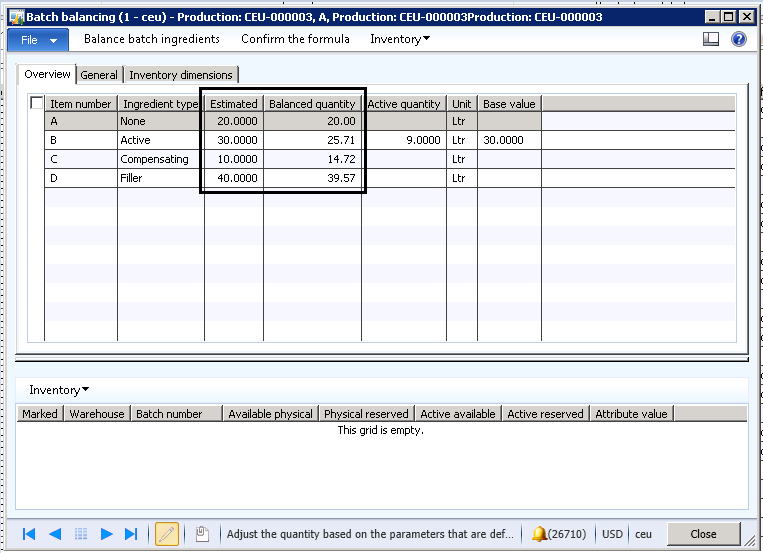Use of ingredient types for batch balancing in production
In an earlier blog post, https://blogs.msdn.com/b/axmfg/archive/2012/12/05/what-s-new-in-microsoft-dynamics-ax-2012-r2-potency-management.aspx#10421522, we introduced the new capabilities in Microsoft Dynamics AX 2012 R2 that support potency management business processes for process industries. This blog provides more information about the four ingredient types that were introduced, None, Active, Compensating, and Filler, and the impact that they have on how quantities are calculated for batch orders.
There are many examples of the use of potency; in chemical industry the percentage of caustic can be characterized as an active ingredient in Pottassium Hydroxide, alcohol can be an active ingredient is liqueurs or fat can be an active ingredient in foods. The amout of active ingredient will often vary around a target value for these products, and the purchase price and the amount to consume in further production will often be affected by this variation. The batch balancing process, which is described in more details here, is focusing on how to take this variation into account
The key to setup formulas, where items with active ingredients must be taken into account, is by the use of the Ingredient types on the formula lines. For the example we will be looking at product A, B, C and D which each represent a seperate Ingredient type.
Ingredient type: Active
You can specify the potency of a product by defining the percentage of its active ingredient. When a product with an active ingredient is included in a formula, the ingredient type on the formula line gets the value Active and cannot be changed. Products must have a potency specified for them before they can be used as an active ingredients in formulas.
The potency of a product is defined by the use of a base attribute of the product. The base attribute is specified from the Manage inventory tab on the Action Pane in the Released products form. Before the base attribute can be associated with a product, the product must have the following setup:
- The batch dimension must be active for the product. This is done by assigning to the product a tracking dimension group with an active batch dimension.
- The attribute that will act as the base attribute for the product must be defined as a product specific batch attribute for the product. (Manage inventory > Batch attributes > Product specific). The associated attribute must have minimum, maximum, and target values.
The balanced quantity of an active ingredient is calculated according to the target value specified for the base attribute. Batch orders for products that have active ingredients in their formulas must go through a batch
balancing process. The batch balancing process is carried out from the Batch balancing form, which is available from the Batch orders list page and Batch order details form when the batch order status is Started. The batch balancing process estimates the amount of each ingredient in the formula that is required to produce the product. The estimation is based on the potency of the on-hand batches that are selected for the production.
Example
Ingredient B has a base attribute X and a target value of 30, and it’s included in a formula that requires 30 liters of Ingredient B for every 100 liters of the product. A batch order is created with a batch size of 100 liters. The batch order is started, and during the batch balancing process the user points to a batch of Ingredient B that has a potency level of 35. Because the potency level of 35 is higher than the target value of 30, the balanced quantity of ingredient B is reduced with the ratio of the potency value and the target value of the batch compared to the estimated quantity. The calculation of the balanced quantity looks like this:
(30/35) * 30 Liters = 25,71 Liters.
Ingredient type: None
When using this type there will be no difference between the estimated quantity and the balanced quantity when performing the batch balancing operation.
Example
Ingredient A is assigned to an ingredient type None, and is added to a formula for a finished product. The formula calls for 10 liters of Ingredient A for every 100 liters of the finished product. When a batch order requires 200 liters both the estimated and the balanced quantity of Ingredient A is calculated as 20 liters.
Ingredient type: Compensating
A compensating ingredient can either offset or compliment the effect of the active ingredient in a product. Therefore, the quantity of a compensating ingredient that will be consumed depends on the potency of the product.
- Opposing effect - If the amount of the active ingredient is higher than anticipated, less of the compensating ingredient is required. The earlier blog gave an example of ice-cream, where cream compensates for a higher concentration of fat in milk.
- Complementary effect - If the amount of the active ingredient is lower than anticipated, you need to add more compensating ingredient. The earlier blog used potato chips as an example, where more oil was added to the boiling process when the degree of moisture in the potatoes is higher than anticipated.
The relation between an active ingredient and a complementary ingredient is set up in the “Compensating principle” form, which is available from the Action Pane in the Formula lines form. You need to select the line that represents a compensating principle, and then point to the active ingredient you want to compensate. In the compensating principle, you also specify a positive or negative compensating factor to determines how much to compensate for and whether the principle should be opposing or complementary. A positive factor is used for complementary, and a negative factor is indicates opposing.
Example
Ingredient B is an active ingredient that has a base attribute X and a target value of 30. It’s included in a formula that requires 30 liters of Ingredient B for every 100 liters of the product. Ingredient C is a compensating ingredient, and is included in the same formula with a quantity of 10. The compensating principle is set up with a factor of 1.10. With a factor of 1.10, the balanced quantity of the compensating ingredient will be reduced by the difference between the active ingredient’s balanced quantity and the estimated required quantity multiplied by 1.10
In a previous example, the balanced quantity of the active ingredient needed was calculated to 25.71, and the estimated required quantity was calculated to 30. In this case, the balanced quantity of the compensating ingredient would be calculated as follows:
Difference between estimated and balanced quantity:
25.71 - 30 = - 4.29
Multiplied with compensating factor:
4.29 * 1.10 = - 4,72
Compensating estimated quantity will be reduced with -4.72 in order to calculate balanced compensating quantity:
10 - (- 4.72) = 14.72
Because 1.10 is a positive factor, this is a compensating principle with a complementary effect. And because the active ingredient is more potent than anticipated, more of the compensating ingredient is required.
Ingredient type: Filler
The filler ingredient is a neutral ingredient used to reach the desired output quantity of the finished product. Adjustment to the filler quantities are calculated based on variations in the active and compensating ingredient compared to the standard quantity.
Example:
We have formulated a product with ingredient A, B, C and D for a formula size of 100 liters. We have calculated the balanced quantity of all the ingredient types except for the line with ingredient type Filler. The balanced quantity of the filler ingredient calculates as the difference between the batch size of 100 liters and the sum of the ingredients:
100 – 20 – 25.71 – 14.72 = 39.57
